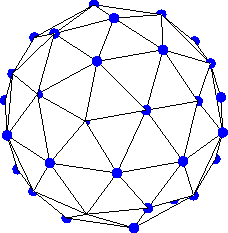| Title | Numerical methods for inverse scattering problems | ||||||||||||||
| Participant | Klaus Giebermann | ||||||||||||||
| Key words | scattering theory, integral equations, ill-posed problems, sampling method | ||||||||||||||
| Description |
Inverse Scattering ProblemsThe aim of inverse obstacle scattering problem is to determine the shape of one ore more obstacles by the knowledge of the scattered wave far away. This problem turns out to be an ill-posed , non-linear problem. This means that we want to invert a non-linear operator which has, unfortunately, no bounded inverse. Therefore, we have to regularize the problem.Typically, the problem is formulated as a non-linear optimization problem. In this project, we focus on a new class of methods to deal with the inverse-scattering problem. Regularized Sampling Method (RSM)The method can be charaterized as follows: for every point x in try solve a linear integral equation where the right hand side depends
on x. The kernel of the integral operator is given by the measured farfield.
If the integral equation can be solved easily, i.e., if the norm of the
solution is small, then x is assumed to lie inside the obstacle, otherwise outside.
try solve a linear integral equation where the right hand side depends
on x. The kernel of the integral operator is given by the measured farfield.
If the integral equation can be solved easily, i.e., if the norm of the
solution is small, then x is assumed to lie inside the obstacle, otherwise outside.
Example  The farfield for 42 incident waves is measured in 42 directions, where
the directions are given as points on the unit sphere.
The farfield for 42 incident waves is measured in 42 directions, where
the directions are given as points on the unit sphere.
The experiment leads to the following farfield-data:
We can use the RSM for the reconstruction of multiple obstacles, too:
Bibliography
|
|
Related projects
|
| |